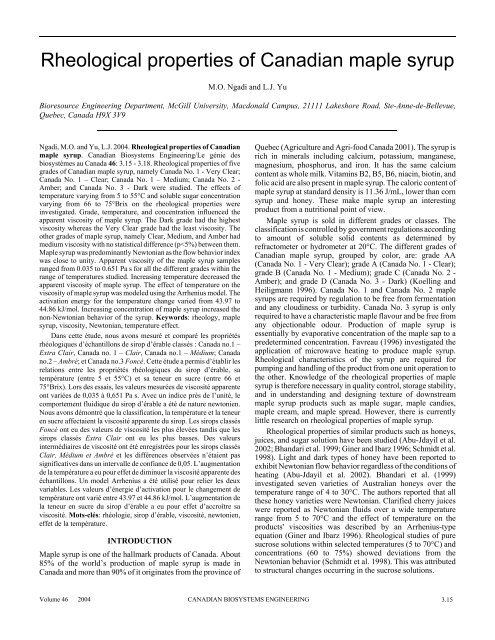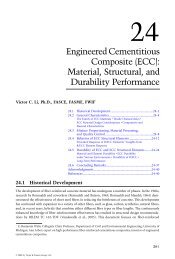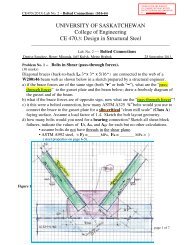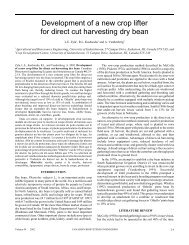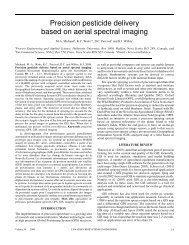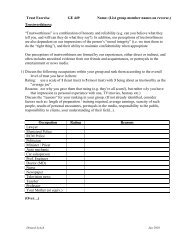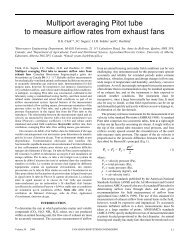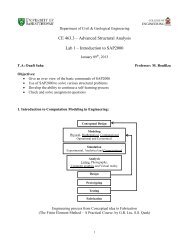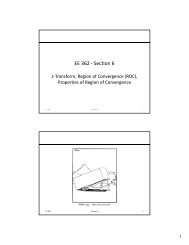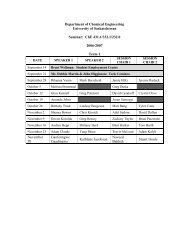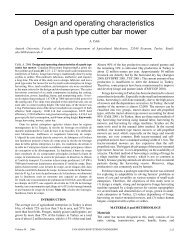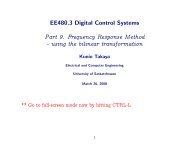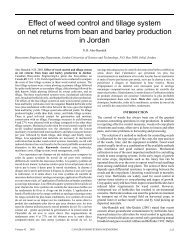Rheological properties of Canadian maple syrup
Rheological properties of Canadian maple syrup
Rheological properties of Canadian maple syrup
You also want an ePaper? Increase the reach of your titles
YUMPU automatically turns print PDFs into web optimized ePapers that Google loves.
<strong>Rheological</strong> <strong>properties</strong> <strong>of</strong> <strong>Canadian</strong> <strong>maple</strong> <strong>syrup</strong><br />
M.O. Ngadi and L.J. Yu<br />
Bioresource Engineering Department, McGill University, Macdonald Campus, 21111 Lakeshore Road, Ste-Anne-de-Bellevue,<br />
Quebec, Canada H9X 3V9<br />
Ngadi, M.O. and Yu, L.J. 2004. <strong>Rheological</strong> <strong>properties</strong> <strong>of</strong> <strong>Canadian</strong><br />
<strong>maple</strong> <strong>syrup</strong>. <strong>Canadian</strong> Biosystems Engineering/Le génie des<br />
biosystèmes au Canada 46: 3.15 - 3.18. <strong>Rheological</strong> <strong>properties</strong> <strong>of</strong> five<br />
grades <strong>of</strong> <strong>Canadian</strong> <strong>maple</strong> <strong>syrup</strong>, namely Canada No. 1 - Very Clear;<br />
Canada No. 1 – Clear; Canada No. 1 – Medium; Canada No. 2 -<br />
Amber; and Canada No. 3 - Dark were studied. The effects <strong>of</strong><br />
temperature varying from 5 to 55°C and soluble sugar concentration<br />
varying from 66 to 75°Brix on the rheological <strong>properties</strong> were<br />
investigated. Grade, temperature, and concentration influenced the<br />
apparent viscosity <strong>of</strong> <strong>maple</strong> <strong>syrup</strong>. The Dark grade had the highest<br />
viscosity whereas the Very Clear grade had the least viscosity. The<br />
other grades <strong>of</strong> <strong>maple</strong> <strong>syrup</strong>, namely Clear, Medium, and Amber had<br />
medium viscosity with no statistical difference (p
Fig. 1. Flow curves for different grades <strong>of</strong> <strong>maple</strong> <strong>syrup</strong> at<br />
5°C.<br />
Fig. 2. Flow curves for different grades <strong>of</strong> <strong>maple</strong> <strong>syrup</strong> at<br />
55°C.<br />
The objectives <strong>of</strong> this work were to determine the<br />
rheological <strong>properties</strong> <strong>of</strong> different grades <strong>of</strong> <strong>Canadian</strong> <strong>maple</strong><br />
<strong>syrup</strong> and to determine the influence <strong>of</strong> temperature and<br />
concentration on the rheological <strong>properties</strong> <strong>of</strong> <strong>maple</strong> <strong>syrup</strong>.<br />
3.16<br />
MATERIALS and METHODS<br />
Five grades <strong>of</strong> <strong>Canadian</strong> <strong>maple</strong> <strong>syrup</strong> were selected for the<br />
study. These were Canada No. 1 - Very Clear; Canada No. 1 –<br />
Clear; Canada No. 1 – Medium; Canada No. 2 - Amber and<br />
Canada No. 3 - Dark. The samples were obtained from the<br />
Citadelle Maple Syrup Producers' Cooperative (Plessisville,<br />
QC). Total soluble solids <strong>of</strong> <strong>maple</strong> <strong>syrup</strong> samples ( ° Brix) were<br />
measured at 20°C using a refractometer (ATC, 0-90%, Fischer<br />
Scientific, Nepean, ON). The Brix scale is particularly well<br />
suited for measuring the density <strong>of</strong> <strong>maple</strong> <strong>syrup</strong> since 98% <strong>of</strong><br />
the dissolved solids are sugar (Koelling and Heiligmann 1996).<br />
Maple <strong>syrup</strong> samples with higher concentrations were obtained<br />
by evaporating regular samples using a hot plate (Corning<br />
Stirrer/hotplate, PC-520, Corning Inc., Corning, NY). The<br />
samples were stirred continuously while heating until the<br />
desired concentrations were attained.<br />
<strong>Rheological</strong> measurement was by using a rheometer<br />
(AR2000, TA Instruments, New Castle, DE). The peltier<br />
controlled concentric cylinder system with DIN geometry was<br />
used. The rotor and stator radius <strong>of</strong> the concentric cylinder were<br />
14 and 15 mm, respectively. The immersed height was 42 mm;<br />
the gap was 5920 :m; and the approximate sample volume was<br />
19.6 mL. <strong>Rheological</strong> measurements were conducted at the<br />
constant temperatures <strong>of</strong> 5, 15, 25, 35, 45, and 55°C. Sample<br />
temperature during test was controlled automatically by the<br />
peltier system <strong>of</strong> the concentric cylinder system. The flow<br />
procedure used was a continuous ramp, shear rate varying from<br />
50 to 500 s -1 (50 to 500 s -1 and 500 to 50 s -1 for thixotropy test).<br />
Two replicates were conducted for all <strong>of</strong> the rheological<br />
measurements. Statistical analysis <strong>of</strong> data was by using the SAS<br />
s<strong>of</strong>tware (SAS Version 8, SAS Institute Inc., Cary, NC).<br />
Statistical significance was determined at p < 0.05. The best-fit<br />
rheological model for the stress - shear data was determined<br />
from three different models, namely, the Newtonian, Power law,<br />
and Bingham equations. The model with the least standard error<br />
was selected as the best fit model.<br />
RESULTS and DISCUSSION<br />
The five grades <strong>of</strong> <strong>maple</strong> <strong>syrup</strong> samples used in this study<br />
measured the same value for total soluble solids at 66°Brix<br />
before they were further concentrated. This implies that all the<br />
grades <strong>of</strong> <strong>maple</strong> <strong>syrup</strong> samples have the same standard density<br />
and have the same total sugar content in accordance with<br />
regulatory specifications (Favreau 1996). Typical shear stress<br />
versus shear rate responses <strong>of</strong> the various grades are shown in<br />
Figs. 1 and 2 for the constant temperatures <strong>of</strong> 5 and 55°C,<br />
respectively. As expected, shear stress increased with increasing<br />
shear rate in a fairly linear fashion.<br />
The three rheological models, namely Newtonian, Power<br />
law, and Bingham were fitted to the experimental data. The<br />
Power law and Bingham models have one parameter more than<br />
the Newtonian model. The standard errors obtained using the<br />
various models were compared. The results indicate that<br />
between the tested models, the Power law model had the least<br />
standard error. The Power law model more closely described the<br />
flow behavior <strong>of</strong> the <strong>maple</strong> <strong>syrup</strong> samples regardless <strong>of</strong> their<br />
grades and temperatures. Values <strong>of</strong> the parameters for the Power<br />
law models at the different temperatures are presented in<br />
Table 1. The flow behavior indexes varied between 0.980 and<br />
1.015 for all the samples. Within the narrow temperature range<br />
<strong>of</strong> 25 to 45°C, the flow behavior indexes were closer to unity<br />
varying between 0.990 and 1.007. Herh et al. (2000) measured<br />
the flow characteristics <strong>of</strong> light and regular <strong>maple</strong> <strong>syrup</strong> (grades<br />
not identified) at 37°C. The authors reported that the regular<br />
<strong>maple</strong> <strong>syrup</strong> was predominately Newtonian whereas the light<br />
<strong>syrup</strong> showed some non-Newtonian flow behavior. The results<br />
obtained in this study over the wider temperature range<br />
corroborated the results <strong>of</strong> Herh et al. (2000). Maple <strong>syrup</strong> is<br />
predominantly Newtonian especially within the temperature<br />
range <strong>of</strong> 25 to 45°C. However, depending on the grade <strong>of</strong> the<br />
<strong>syrup</strong>, it showed very slight deviation from Newtonian at<br />
temperatures outside the temperature range.<br />
Values <strong>of</strong> apparent viscosities <strong>of</strong> <strong>maple</strong> <strong>syrup</strong> were from<br />
0.035 to 0.651 Pa s for the different grades <strong>of</strong> <strong>maple</strong> <strong>syrup</strong>s and<br />
temperatures. Scarce information is available in the literature.<br />
The viscosity <strong>of</strong> <strong>maple</strong> <strong>syrup</strong> at 25°C has been reported as<br />
0.1635 Pa s (Johnson 1997). The reported viscosity is within the<br />
range obtained in this study. Statistical analysis <strong>of</strong> the data<br />
obtained for the regular <strong>maple</strong> <strong>syrup</strong> concentration (66°Brix)<br />
showed that type <strong>of</strong> <strong>syrup</strong> and temperature significantly<br />
LE GÉNIE DES BIOSYSTÈMES AU CANADA NGADI and YU
Table 1. Parameters <strong>of</strong> the Power Law model for <strong>maple</strong><br />
<strong>syrup</strong> at different temperatures.<br />
Grade <strong>of</strong> <strong>syrup</strong> Temperature<br />
(°C)<br />
Canada No. 1<br />
Very Clear<br />
Canada No. 1<br />
Clear<br />
Canada No. 1<br />
Medium<br />
Canada No. 2<br />
Amber<br />
Canada No. 3<br />
Dark<br />
5<br />
15<br />
25<br />
35<br />
45<br />
55<br />
5<br />
15<br />
25<br />
35<br />
45<br />
55<br />
5<br />
15<br />
25<br />
35<br />
45<br />
55<br />
5<br />
15<br />
25<br />
35<br />
45<br />
55<br />
5<br />
15<br />
25<br />
35<br />
45<br />
55<br />
K<br />
(Pa s)<br />
0.610<br />
0.283<br />
0.138<br />
0.074<br />
0.045<br />
0.029<br />
0.634<br />
0.335<br />
0.157<br />
0.083<br />
0.048<br />
0.032<br />
0.645<br />
0.299<br />
0.149<br />
0.081<br />
0.051<br />
0.035<br />
0.689<br />
0.313<br />
0.154<br />
0.083<br />
0.049<br />
0.032<br />
0.719<br />
0.319<br />
0.160<br />
0.086<br />
0.053<br />
0.041<br />
n Standard<br />
error<br />
1.000<br />
0.995<br />
1.000<br />
0.997<br />
1.007<br />
1.015<br />
1.006<br />
0.980<br />
0.990<br />
0.997<br />
1.006<br />
1.012<br />
0.998<br />
0.993<br />
0.996<br />
1.000<br />
0.994<br />
1.000<br />
0.989<br />
0.987<br />
0.991<br />
0.996<br />
1.000<br />
1.012<br />
0.991<br />
0.991<br />
0.992<br />
1.000<br />
1.000<br />
1.001<br />
τ = Kγ n & τ & γ<br />
Model: , where: = shear stress (Pa), = shear<br />
0.982<br />
0.475<br />
0.378<br />
0.863<br />
2.055<br />
3.262<br />
0.681<br />
0.846<br />
0.568<br />
1.359<br />
2.122<br />
2.099<br />
0.996<br />
0.441<br />
0.468<br />
1.157<br />
1.815<br />
2.603<br />
1.022<br />
0.529<br />
0.470<br />
0.869<br />
1.497<br />
2.219<br />
1.191<br />
0.487<br />
0.442<br />
0.444<br />
1.974<br />
2.019<br />
rate (s -1 ), n = power law index, and K = consistency (Pa s n ).<br />
(p 0.99) as given in Eqs. 1, 2, and 3.<br />
Canada No. 1 - Very Clear<br />
−9<br />
⎛ 44. 86⎞<br />
µ = 2. 05× 10 exp⎜<br />
⎟<br />
⎝ RT ⎠<br />
Canada No. 1 - Clear<br />
Canada No. 1 - Medium<br />
Canada No. 2 - Amber<br />
−9<br />
⎛ 44. 86⎞<br />
µ = 2. 18 × 10 exp⎜<br />
⎟<br />
⎝ RT ⎠<br />
Canada No. 3 - Dark<br />
−9<br />
⎛ 4397 . ⎞<br />
µ = 3. 32 × 10 exp⎜<br />
⎟<br />
⎝ RT ⎠<br />
where:<br />
: = viscosity (Pa s),<br />
R = gas constant (8.314 x 10 -3 kJ/mol K), and<br />
T = temperature (K).<br />
Activation energies obtained were 44.86 kJ/mol for the Very<br />
Clear type, 44.86 kJ/mol for the Clear, Medium and Amber<br />
types, and 43.97 kJ/mol for the Dark type. The activation energy<br />
values for all types <strong>of</strong> <strong>maple</strong> <strong>syrup</strong> were very similar. Activation<br />
energy indicates sensitivity to temperature changes. The<br />
sensitivity <strong>of</strong> the different types <strong>of</strong> <strong>maple</strong> <strong>syrup</strong>s to temperature<br />
changes may be close considering their activation energy values.<br />
The Dark <strong>maple</strong> <strong>syrup</strong> type had higher frequency factor<br />
compared to the other types. Considering the activation energy<br />
and frequency factor values <strong>of</strong> the different types <strong>of</strong> <strong>maple</strong><br />
<strong>syrup</strong>, differences in response to temperature changes become<br />
more apparent at lower temperatures.<br />
The effect <strong>of</strong> concentration on the rheological behavior <strong>of</strong><br />
<strong>maple</strong> <strong>syrup</strong> was studied using the concentrations <strong>of</strong><br />
proximately 70 and 75°Brix at a temperature <strong>of</strong> 35°C. Statistical<br />
analysis showed that concentration effect was significant (p <<br />
0.0001). The Power law model can also well describe the flow<br />
behavior <strong>of</strong> the concentrated samples. Parameters <strong>of</strong> the Power<br />
law model are shown in Table 2. The flow behavior index was<br />
between 0.969 and 0.992 indicating increased departure from<br />
Newtonian behavior compared to the non-concentrated samples<br />
at 66°Brix. This result is similar to several works on pure<br />
sucrose solutions that report larger departure from Newtonian<br />
3.17<br />
(1)<br />
(2)<br />
(3)
Table 2. Parameters <strong>of</strong> the Power Law model for<br />
concentrated <strong>maple</strong> <strong>syrup</strong> at 35°C.<br />
3.18<br />
Grade <strong>of</strong> <strong>syrup</strong> °Brix K<br />
(Pa s)<br />
Canada No. 1<br />
Very Clear<br />
Canada No. 1<br />
Clear<br />
Canada No. 1<br />
Medium<br />
Canada No. 2<br />
Amber<br />
Canada No. 3<br />
Dark<br />
66<br />
70<br />
75<br />
66<br />
70<br />
75<br />
66<br />
70<br />
75<br />
66<br />
70<br />
75<br />
66<br />
70<br />
75<br />
0.074<br />
0.208<br />
0.595<br />
0.0826<br />
0.1364<br />
0.5125<br />
0.081<br />
0.181<br />
0.815<br />
0.083<br />
0.273<br />
0.966<br />
0.086<br />
0.168<br />
1.066<br />
n Standard<br />
error<br />
0.997<br />
0.991<br />
0.989<br />
0.997<br />
0.992<br />
0.978<br />
1.000<br />
0.988<br />
0.971<br />
0.996<br />
0.976<br />
0.988<br />
1.000<br />
0.991<br />
0.969<br />
τ = Kγ n & τ & γ<br />
0.863<br />
1.265<br />
0.817<br />
1.359<br />
0.945<br />
0.829<br />
1.157<br />
0.575<br />
1.424<br />
0.869<br />
1.116<br />
1.396<br />
0.444<br />
0.911<br />
1.202<br />
Model: , where: = shear stress (Pa), = shear<br />
rate (s-1 ), n = power law index, and K = consistency (Pa sn ).<br />
behavior when solutions were concentrated. This is due to<br />
structure changes in the solution (Schmidt et al. 1998). Further<br />
and detailed studies should be designed to investigate<br />
rheological and structural changes in <strong>maple</strong> <strong>syrup</strong> resulting from<br />
concentration and their influence on <strong>maple</strong> <strong>syrup</strong> products.<br />
CONCLUSION<br />
Grade, temperature, and concentration <strong>of</strong> <strong>maple</strong> <strong>syrup</strong><br />
influenced its flow <strong>properties</strong>. The Canada No. 3 – Dark was<br />
more viscous than the other grades. The Canada No. 1 - Very<br />
Clear had the least viscosity. Other grades such as Canada No.<br />
1 - Clear, Canada No. 1 - Medium, and Canada No. 2 - Amber<br />
had medium viscosity. The power law equation provided the<br />
best model for the experimental data obtained for the <strong>maple</strong><br />
<strong>syrup</strong> samples. However, the flow behavior indexes were close<br />
to unity indicating that <strong>maple</strong> <strong>syrup</strong> was largely Newtonian<br />
especially between the temperatures <strong>of</strong> 25 to 45°C. The effect<br />
<strong>of</strong> temperature on viscosity was modeled using the Arrhenius<br />
equation.<br />
ACKNOWLEDGEMENT<br />
The authors acknowledge the part contribution <strong>of</strong> the Citadelle<br />
Maple Syrup Producers' Cooperative, Quebec.<br />
REFERENCES<br />
Agriculture and Agri-food Canada. 2001. Canada’s Maple<br />
Syrup Industry. Report compiled by Jacquelin Cote and<br />
Mike Leclair. Agriculture and Agri-food Canada, Market<br />
and Industry Services Branch, Ottawa, ON.<br />
Abu-Jdayil, B., A.A. Ghzawi, K.I.M. Al-Malah and S. Zaitoun.<br />
2002. Heat effect on rheology <strong>of</strong> light and dark-colored<br />
honey. Journal <strong>of</strong> Food Engineering 51: 33-38.<br />
Bhandari, B., B. D’Arcy and S. Chow. 1999. Rheology <strong>of</strong><br />
selected Australian honeys. Journal <strong>of</strong> Food Engineering<br />
41: 65-68.<br />
Favreau, D. 1996. Microwave Processing <strong>of</strong> Maple Syrup.<br />
Unpublished M.Sc. thesis. McGill University, Macdonald<br />
Campus, Montreal, QC.<br />
Giner, J. and A. Ibarz. 1996. Rheology <strong>of</strong> clarified cherry<br />
juices. Journal <strong>of</strong> Food Engineering 30: 155-162.<br />
Herh, P.K.W., S.M. Colo, N. Roye and K. Hedman. 2000.<br />
<strong>Rheological</strong> <strong>of</strong> foods: New techniques, capabilities and<br />
instruments. American Laboratory June 2000: 16-20.<br />
Johnson, A.T. 1997. Biological Process Engineering: An<br />
Analogical Approach to Fluid Flow, Heat Transfer and<br />
Mass transfer Applied to Biological Systems. New York,<br />
NY: John Wiley and Sons, Inc.<br />
Koelling M.R. and R.B. Heiligmann. 1996. North American<br />
Maple Syrup Producers Manual. Extension Bulletin 856.<br />
Columbus, OH: The Ohio State University.<br />
Schmidt, T., D. Christoph and B. Senge. 1998. Non-Newtonianbehavior<br />
<strong>of</strong> pure sucrose solution. ICUMSA 1998.<br />
LE GÉNIE DES BIOSYSTÈMES AU CANADA NGADI and YU


